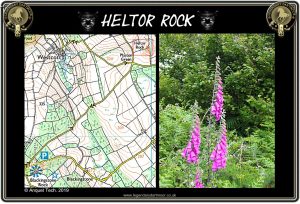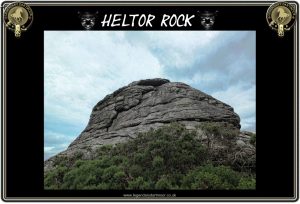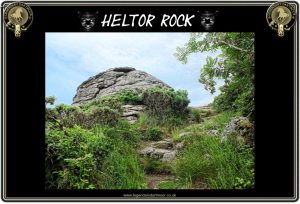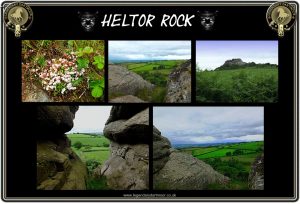
“About 1. m. N. of Bridford, and on a hill that sweeps abruptly down to the Teign, is Hel Tor, whence the climber to its breezy summit looks over a wide extent of East Devon, the panorama being as beautiful as it is varied.”, Crossing, p.268.
William Crossing was not exaggerating when he wrote about the tremendous views that can be enjoyed from Hel Tor as he correctly calls it. The place-name first appeared in the Feet of Fines of 1612 when it was written as Heltor and so it remained on many early Ordnance Survey maps right up until the 20th century. For some odd reason the early maps show it as Hel Tor Rock but then sometime in the 20th century the O.S. decided to save money on printing and joined the two word to give Heltor. Near to the tor are two farms that take its name; Lower Heltor and Middle Heltor although it could be that the present Thorn Farm was once Higher Heltor? Worth suggests that the place-name derives from the old Anglo Saxon word Helle meaning basically ’eminent’ which certainly would apply the Heltor or ’eminent tor’. He also records that another name Heltor has gone under is Whitestone, p.426. However, according to my Anglo Saxon dictionary the word Helle means ‘Hell’ which gives a completely different connotation, Clark Hall, p.176. So we either get from the name the ’eminent tor’ or the ‘hell tor’. Just by chance there is an old folk tale that tells the story of how way back in the dim and distant past King Arthur and the Devil were having an argument, about what everyone has forgotten. So it was decided to settle the dispute by hurling mighty quoits at each other. The Devil settled himself on the hill where Heltor sits today and King Arthur where Blackingstone Rock sits today. As the battle commenced huge, gigantic quoits began flying through the air and wherever they landed they turn to stone. One of these being Heltor and the other Blackingstone Rock, judging by both their sizes I would imagine that both opponents managed to get out of the way in time to carry on with their later exploits? If not I have a good idea what’s buried under each granite outcrop. . Now is this just a coincidence that the Devil took up his position where Heltor stands today and that the old Saxon word helle alludes to his fiery abode and there we have the source of the place-name. Or did some local with a fanciful imagination tailor the legend around the place-name which merely meant ’eminent tor’?
As far as the tor goes one can say that it sits at an altitude of just over 300 metres and comprises of two piles of granite with a narrow avenue between the outcrops. There six rock basins on the two outcrops (3 on the northern outcrop and three on the southern outcrop) which along with the avenue certainly adds a Druidical atmosphere to the place. It has been said that when viewed from Dunsford the tor gives the appearance of an ancient castle’s keep standing sentinel above all it surveys. There is a claim that Heltor is the nearest of the Dartmoor tors to Exeter being some 11 miles away.
Heltor does in fact sit on private land however there is a permissible footpath that leads up to the tor from the stile of which sits at O.S.Grid Ref. SX 8000 8683. On the day I visited it was clear that this footpath is not often used as the vegetation was quite dense to say the least. But every cloud has a silver lining because the variety of plant-life growing alongside the hedgerow was a sight to delight. Bright pink Foxgloves sprang up everywhere along with Red Campion, Colt’s Foot, Honeysuckle, Ox-Eye Daisies, Gorse, Bracken and a host of other flowers I am too ignorant to name. On the tor itself clumps of Stonecrop seemed to cling to every inch of exposed granite and is probably the most I have ever seen in such a small area. Having been treated to a botanical delight on the way up I was then equally rewarded by the extensive views afforded from the summit. Sadly it was not that a clear day but even so very impressive and enough to make you want to sit and stare for a while. One could feel quite sad for poor old Heltor because if you look at the OS map above they give Blackingstone Rock the accolade of a viewpoint symbol. But as mentioned the views are just as good on Heltor but it doesn’t get the same treatment.
If you ever find yourself travelling between Bridford and Moretonhampstead keep a lookout for a well hidden and overgrown stile in the hedgerow, park on the verge and have a wander up to the ‘Devil’s Quoit’ or eminent tor you will not be disappointed.
![]()

Clark Hall, J. R. 2004. A concise Anglo-Saxon Dictionary. London: Toronto University Press.
Crossing, W. 1990. Crossing’s Guide to Dartmoor. Newton Abbot; Peninsula Press.
Worth, R. H. 1988. Worth’s Dartmoor. Newton Abbot: David & Charles.
 Legendary Dartmoor The many aspects past and present of Dartmoor
Legendary Dartmoor The many aspects past and present of Dartmoor




